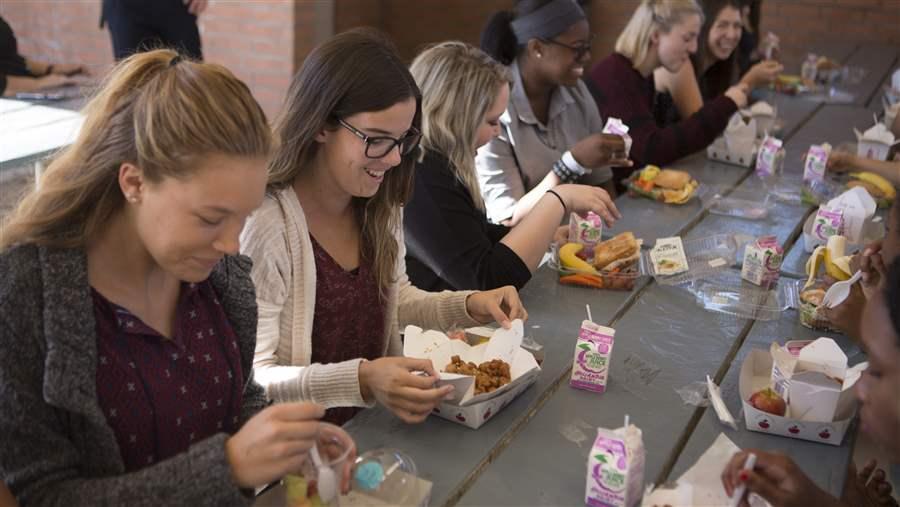Pew and RWJF: Schools Report Growing Success With Healthier Menus
Most meal programs increased total revenue in 2014-15 school year, survey finds

The report offers lessons from the panelists’ experiences and recommendations to help states, districts, families, and communities enhance meal programs’ success in implementing updated nutrition standards and encouraging healthy eating among students.
© The Pew Charitable Trusts
WASHINGTON—School food service directors are using a mix of strategies—three, on average—to encourage students to eat healthy meals and snacks, and many see few or no remaining challenges to implementing updated breakfast and lunch nutrition standards. The findings come from a new report from the Kids’ Safe and Healthful Foods Project, a collaboration between The Pew Charitable Trusts and the Robert Wood Johnson Foundation.
Based on a nationally representative survey of food service directors, the report, School Meal Programs Innovate to Improve Student Nutrition, sheds light on which approaches have been most effective during the multiyear transition to healthier food and drink standards issued by the U.S. Department of Agriculture since 2011. A panel of school nutrition professionals, whose programs are successfully serving healthy meals and snacks, reviewed the survey results and provided additional insights on effective approaches to implementing updated nutrition rules. The research finds that:
- Near the end of the 2014-15 school year, 6 in 10 directors said they faced few or no ongoing obstacles to meeting updated breakfast requirements; 4 in 10 said the same about the lunch guidelines.
- For breakfast and lunch, the most commonly cited challenges were two rules that took effect in school year 2014-15: tighter limits on weekly average sodium content and a requirement that any food counted as a grain serving be made from at least 50 percent whole grains.
- 9 in 10 directors adopted at least one practice to raise children’s fruit and vegetable consumption. For example, almost two-thirds of directors who increased the use of salad bars said that kids ate more produce as a result.
- Respondents said that holding taste tests with students and redistributing uneaten, sealed foods were among the most effective ways to reduce waste, but only 44 percent and 38 percent of programs, respectively, used these strategies.
- Directors whose programs prepared more foods from scratch and increased the use of salad bars were more likely to report that student participation rose or was unchanged from SY 2011-12 to 2014-15. Conversely, declines in participation were seen most often by directors who purchased more commercially prepared foods or decreased menu options.
- Equipment and labor costs were the most frequently reported financial concerns (38 percent and 33 percent, respectively).
- 84 percent of program directors reported rising or stable combined revenue (meal reimbursements plus snack and beverage sales) in the past year. More than half (54 percent) of districts saw higher combined revenue in school year 2014-15 compared with a year earlier. Almost a third (30 percent) said total revenue remained level.
“Thousands of districts have emerged from this transition, and many more can see light at the end of the tunnel,” said Stephanie Scarmo, of the Kids’ Safe and Healthful Foods Project. “Successful meal programs have made continuous innovation and collaboration with students their guiding principles, and they’ve worked to improve not just cafeteria menus but what schoolchildren are taught about food, with help from principals, teachers, and parents.”
Food service directors reported uneven progress toward district-wide compliance with the Smart Snacks in School nutrition standards, which govern items sold in cafeteria a la carte lines, vending machines, snack bars, and at fundraisers. In 2013, the USDA issued an interim final Smart Snacks rule that districts were to implement by school year 2014-15. Two-thirds of respondents said that all food and beverages sold by their departments met the standards by the deadline. But only 2 in 10 reported that the same was true for products sold by other departments and school groups. The panel of nutrition professionals suggested that achieving full compliance with the rule would involve greater cooperation between school staff and state child nutrition agencies, as well as support from the broader education community.
“Change doesn’t happen overnight,” said Rodney Taylor, director of food and nutrition services for Fairfax County Public Schools in Virginia and a panel participant. “I always tell my staff: ‘Bug them nicely. Don’t go away. Don’t give up on an idea because this teacher or that parent said no.’ Success requires constantly asking, ‘How do we get better at what we do?’”
The report offers lessons from the panelists’ experiences and recommendations to help states, districts, families, and communities enhance meal programs’ success in implementing updated nutrition standards and encouraging healthy eating among students.
###
The Kids’ Safe and Healthful Foods Project provides nonpartisan analysis and evidence-based recommendations on policies that affect the safety and healthfulness of school foods. The project is a collaboration between The Pew Charitable Trusts and the Robert Wood Johnson Foundation. Learn more at www.healthyschoolfoodsnow.org.


School Meal Programs Innovate to Improve Student Nutrition
Survey explores progress, challenges three years ...
Learn More

Schools Embrace Proven Strategies to Promote Students’ Healthy Eating
Nutrition directors encourage involving kids in food choices, expanding meal service beyond the cafeteria


Healthy School Lunches Improve Kids’ Habits
Strong nutrition standards work, evidence shows






